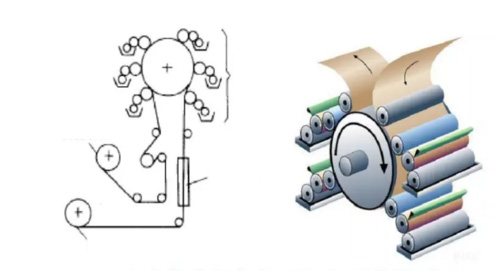The ink transfer principle of flexographic printing machine is a relatively complex but efficient process, which mainly involves the transfer of ink from the ink hopper to the printing plate, and then to the substrate.
Ink transfer principle of flexographic printing machine
Flexographic printing machines use fluid ink with strong fluidity, which is evenly transferred to the substrate through a series of precise components and steps. Specifically, the ink transfer process can be summarized into the following key steps:
Ink supply:
Ink is first stored in the ink fountain, which is the starting point of ink.
Ink transfer to the mesh roller:
Ink is transferred from the ink fountain roller (also known as the ink roller) to the mesh roller (also known as the mesh roller). The surface of the mesh roller is covered with small mesh holes, which can store a certain amount of ink.
When the mesh roller rotates, the mesh holes on its surface will dip into the ink in the ink fountain.
Uniform distribution of ink on the mesh roller:
The mesh roller continues to rotate, and the excess ink on its surface is scraped off by the scraper blade, ensuring that only the ink in the mesh holes is retained. This step is very important because it ensures the uniform distribution of ink on the mesh roller, thereby avoiding ink waste and unnecessary pollution.

Ink is transferred from the mesh roller to the flexible printing plate:
Next, the mesh roller comes into contact with the flexible printing plate. Under the action of pressure, the ink in the mesh roller holes is transferred to the graphic and textual parts of the flexible printing plate. The layout structure of a flexographic printing plate is similar to that of a relief printing plate, with raised graphic and textual parts and depressed non graphic and textual parts. In this way, the ink only adheres to the graphic and textual parts.
Ink transfer from flexible printing plate to substrate:
Finally, under the printing pressure of the pressure roller, the ink on the flexible printing plate is transferred to the substrate (such as paper, plastic film, etc.). The function of the pressure roller is not only to provide printing pressure, but also to ensure that the ink can be evenly and completely transferred to the substrate.
Drying and completion:
After printing is completed, the ink on the substrate usually needs to be dried (such as hot air drying) to ensure that the ink can firmly adhere to the substrate and achieve the expected printing effect.
Characteristics of Ink Transfer Principle in Flexographic Printing Machines
Simple equipment structure: Flexographic printing machines eliminate complex ink roller groups, making the ink transfer system simpler and easier to operate.
Low cost: Due to its simple equipment structure and easy operation, flexographic printing machines have relatively low costs, especially suitable for use by small and medium-sized enterprises.
Easy to control and adjust: The ink transfer process of flexographic printing machines can be precisely controlled by adjusting parameters such as the depth of the mesh holes of the web roller, the angle and pressure of the ink scraper, etc., in order to achieve high-quality printing effects.
The ink transfer principle of a flexographic printing machine is a process of efficiently transferring ink from the ink hopper to the substrate through a web roller and a flexographic printing plate. This principle not only ensures the stability and reliability of printing quality, but also reduces printing costs and improves production efficiency.